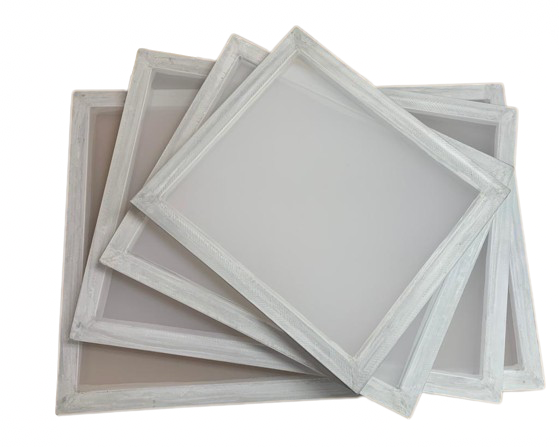
The Ultimate Guide to Choosing the Right Screens for Screen Printing Success
Share
Screen printing is an art form that has been around for centuries, and it continues to be a popular method for creating high-quality, customized prints on various surfaces. Whether you're a seasoned screen printer or just getting started, one of the most critical factors that can make or break your printing success is the choice of screens. In this comprehensive guide, we'll take you through everything you need to know about selecting the right screens for your screen printing endeavors.
Introduction to Screen Printing

Screen printing is a versatile and widely-used printing technique that involves transferring ink through a mesh screen onto a substrate, such as fabric, paper, or wood. The method has been cherished by artists, businesses, and DIY enthusiasts for its ability to produce vibrant and durable prints. However, to achieve the best results, it all starts with choosing the right screens. Read about history of screen printing here.
Understanding the Basics
Screen printing relies on a stencil, which is created on a screen, to allow ink to pass through in specific areas, forming the desired image or design on the substrate. The quality of the stencil and the screen mesh significantly affect the final print's clarity and detail.
Importance of Choosing the Right Screens
Selecting the appropriate screens for your screen printing projects is essential to achieve crisp, precise, and professional-looking prints. The screens you choose will impact the ink deposition, resolution, and overall print quality. In the following sections of this guide, we will delve deeper into various factors to consider when making these crucial decisions.
Types of Screen Printing Screens
Before we dive into the nitty-gritty of screen selection, let's explore the different types of screens commonly used in screen printing. The two primary screen types are:
Mesh Count and Its Significance

Mesh count refers to the number of threads per inch in a screen. It plays a pivotal role in determining how much ink can pass through the screen and onto the substrate. Screens with higher mesh counts provide finer details but require more attention to ink viscosity.
Differences Between Mesh Types
There are various mesh types available, each designed for specific applications. Understanding these differences will help you choose the right screen for your project. Some common mesh types include monofilament, multifilament, and specialty meshes.
Determining the Ideal Mesh Count
The mesh count you choose depends on several factors, including the type of artwork, substrate, and ink you plan to use. Achieving the ideal mesh count for your specific project is crucial for obtaining optimal results.
Factors Affecting Mesh Count Selection
Consider factors such as image complexity, desired ink deposit, and substrate texture when determining the appropriate mesh count. These variables will guide your decision and impact the final print quality.
Finding the Right Balance
Balancing mesh count with ink viscosity and screen tension is a critical aspect of screen printing. Achieving this balance ensures that your prints are sharp, clear, and consistent. Learn more here.
Screen Frame Materials
The frames that hold your screens play a significant role in screen printing. The two primary frame materials used are wood and aluminum, each with its advantages and disadvantages.
Wood vs. Aluminum Frames
Aluminum frames are sturdy and long-lasting, making them a popular choice for professional screen printers. Wooden frames are not used as much as they used to be. You can still find them but most printers use aluminum frames.
Screen Tension
Screen tension refers to the tightness of the mesh on the frame. Proper tension is crucial for achieving consistent and sharp prints.
The Impact of Tension on Print Quality
Inadequate or uneven tension can lead to issues such as uneven ink deposition, distortion, and loss of detail. Maintaining the right tension level is essential for successful screen printing.
Methods for Achieving Proper Tension
Learn about the methods and tools available to achieve and maintain proper screen tension. From manual tensioning to automated systems, you have options to suit your equipment and skill level.
Choosing the Right Emulsion
Emulsion selection is another critical aspect of screen printing. Different emulsions are tailored to specific applications and can greatly affect the stencil's quality. Learn more here.
Types of Emulsion for Different Applications
Explore the various emulsion types available and understand their characteristics. Choosing the right emulsion for your project ensures that your stencils are sharp and durable.
Coating and Exposing Screens
The process of coating screens with emulsion and exposing them to create stencils requires precision. Mastering this step is essential for achieving consistent and reliable results.
Stencil Creation
Creating accurate stencils is the heart of screen printing. Learn about the techniques and tools involved in stencil creation and how they influence the final print.
Creating Stencils for Screen Printing
Discover the methods of creating stencils, including hand-drawn stencils, photographic stencils, and computer-generated stencils. Each approach has its advantages and limitations.
Importance of Accuracy
Precision in stencil creation ensures that your prints accurately reflect your design. Paying attention to details during this phase is crucial for achieving professional results.
Ink and Substrate Considerations
Choosing the right ink and adapting screens for different substrates are vital steps in achieving successful screen printing outcomes.
Matching Ink to Screens
Different inks require specific screen mesh counts and stencil thicknesses. Understanding these relationships will help you select the right screens for your chosen ink.
Adapting Screens for Various Substrates
Screen printing isn't limited to one type of material. Learn how to adapt your screens for printing
on fabric, paper, glass, and other surfaces.
Screen Cleaning and Maintenance
Maintaining your screens properly is essential for their longevity and performance. Explore effective cleaning techniques and best practices.
Extending the Lifespan of Your Screens
Taking care of your screens can save you time and money in the long run. Learn how to clean and store screens to ensure they remain in excellent condition.
Proper Cleaning Techniques
Discover the dos and don'ts of screen cleaning, including the use of solvents, degreasers, and reclaiming screens. Keeping your screens clean is key to consistent print quality.
Screen Storage and Organization
Efficiently storing and organizing your screens is essential, especially if you have multiple projects and screens to manage.
Storing Screens for Future Use
Screens can be reused for future projects, provided they are stored properly. Learn the best practices for storing screens to maintain their quality.
Organizing Screens Efficiently
Whether you have a small home studio or a large commercial operation, organization is key. Find out how to keep your screens organized and accessible.
Troubleshooting Common Screen Printing Issues
Even the most experienced screen printers encounter challenges from time to time. Learn how to identify and resolve common screen printing problems.
Identifying and Resolving Problems
From ink bleeding to uneven prints, discover troubleshooting techniques to address common issues. Quick problem-solving can save your project from setbacks.
Preventing Issues in the First Place
Prevention is the best cure. Explore proactive measures to minimize the occurrence of screen printing problems and ensure smooth production.
Advanced Techniques and Tips
Once you've mastered the fundamentals, you can explore advanced screen printing techniques and insider tips for taking your prints to the next level.
Expanding Your Screen Printing Skills
From halftone printing to four-color process printing, there are numerous advanced techniques to explore. Broaden your skill set and create stunning prints.
Expert Recommendations for Success
Benefit from the wisdom of experienced screen printers as they share their insights and tips for achieving outstanding results in your screen printing projects.
Eco-Friendly Screen Printing
In an age of environmental awareness, screen printers can adopt sustainable practices to minimize their ecological footprint.
Sustainable Practices in Screen Printing
Explore eco-friendly ink options, reduced chemical usage, and sustainable substrate choices. Adopting these practices can appeal to environmentally conscious customers.
Reducing Environmental Impact
Discover ways to reduce waste, energy consumption, and water usage in your screen printing processes. Being eco-friendly can benefit both the planet and your bottom line.
Screen Printing Safety
Safety should always be a priority in any work environment. Learn how to ensure a safe screen printing workspace.
Ensuring a Safe Working Environment
Identify potential hazards in your screen printing space and take steps to mitigate them. Protecting your health and well-being is paramount.
Protective Gear and Precautions
Understand the essential safety gear and precautions necessary for screen printing. Investing in safety measures is an investment in your future.
Conclusion
In conclusion, choosing the right screens for screen printing is a critical aspect of achieving success in this versatile printing method. The screens you select will influence the quality, clarity, and durability of your prints. By understanding the intricacies of mesh count, screen frame materials, tension, emulsion, stencil creation, and more, you can elevate your screen printing game to new heights.
Whether you're a seasoned screen printer looking to refine your skills or a beginner eager to embark on a creative journey, the knowledge gained from this guide will empower you to make informed decisions and produce outstanding screen prints.
If you're ready to embark on your screen printing adventure, remember that your choice of screens is just the beginning. With the right knowledge, practice, and dedication, you can achieve screen printing success and create impressive, customized prints that leave a lasting impression.
FAQs
- What is the minimum mesh count suitable for fine details in screen printing?
- Achieving fine details often requires a mesh count of 200 or higher, depending on the intricacy of the design.
- Can I reuse screens for different projects?
- Yes, screens can be reclaimed and reused for various projects, provided they are cleaned and stored correctly.
- What safety precautions should I take when working with screen printing chemicals?
- Always wear protective gear, such as gloves and goggles, and work in a well-ventilated area when handling screen printing chemicals.
- How can I prevent ink bleeding in screen printing?
- Properly controlling ink viscosity, using the right mesh count, and ensuring accurate screen tension can help prevent ink bleeding.
- Are there eco-friendly alternatives for screen printing inks?
- Yes, eco-friendly inks made from water-based or soy-based formulations are available and can be used to reduce environmental impact.
In this ultimate guide, we've covered the essential aspects of screen printing screens, from selecting the right mesh count to understanding frame materials and maintaining screens. Armed with this knowledge, you're well-equipped to embark on your screen printing journey and achieve success in your printing projects. Happy printing!
